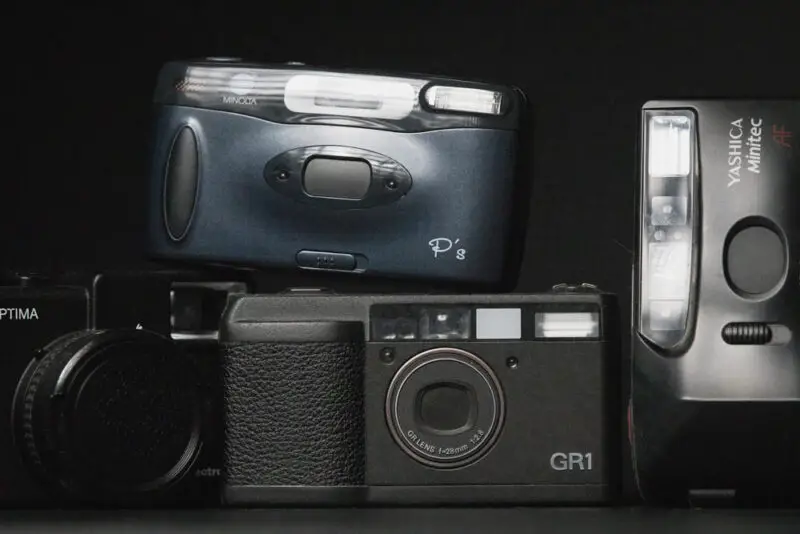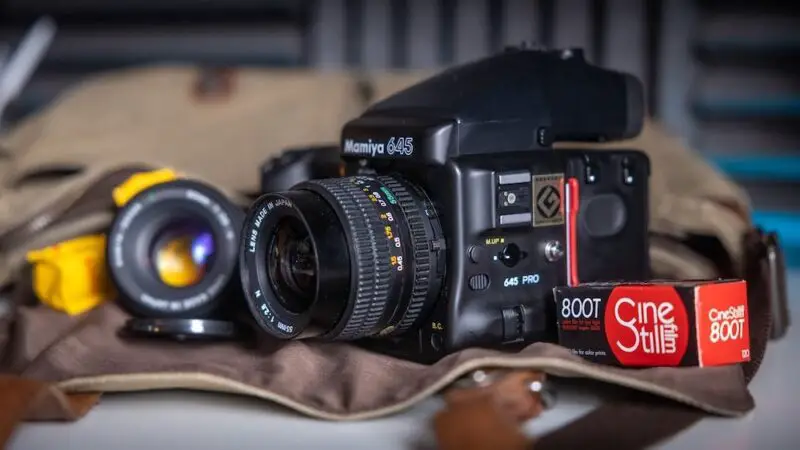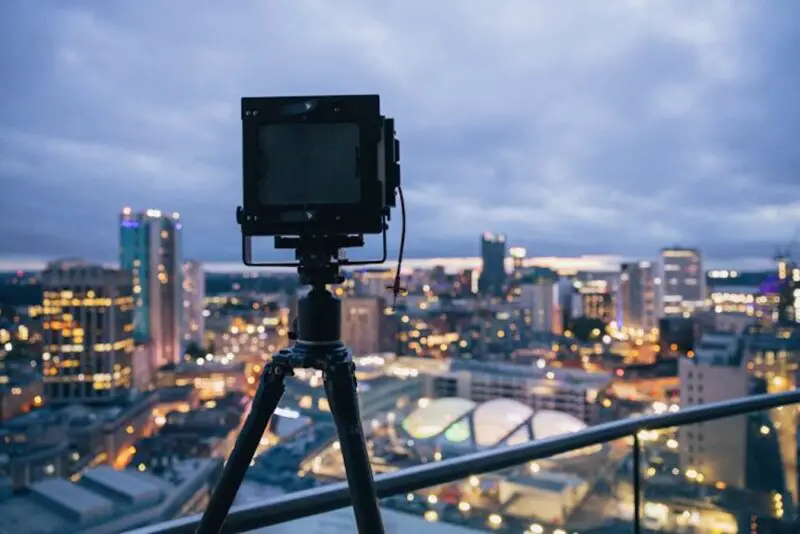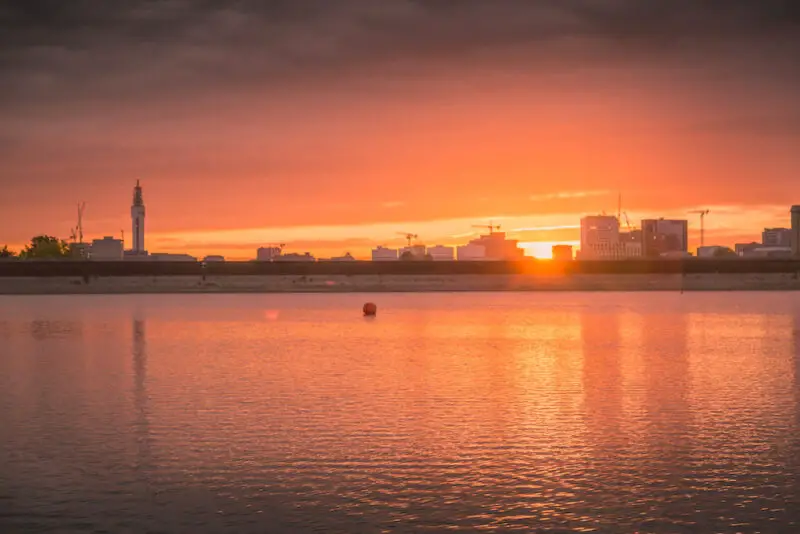As photographers, especially those who are still honing their skills, we face dozens if not hundreds of decisions each day. This includes which lens to take to what kind of strobe to use, when and where to shoot – and even more fundamentally, whether to use a full frame vs crop sensor camera.
Yes, the eternal sensor format debate has raged practically forever.
But why is this issue so dominant in the current discourse? How does it affect the way you shoot and your success as a career photographer?
Without any further ado, let’s strap right in and find out!
- The Meaning Behind Full Frame vs Crop Sensor
- Sensor Format History
- Why Do Sensor Sizes Matter?
- Crop Factors
- Full Frame vs Crop Sensor – A Direct Comparison
The Meaning of ‘Full Frame Vs Crop Sensor’
First off, we need to get our bearings straight. When we have (hopefully not too heated) debates about sensor formats, what are we actually talking about?
As with so many other conventions, rules, and standards in modern photography, history is the answer.
The History of Different Sensor Formats
In the pre-digital days of yore, photographers used films of varying sizes or formats.
A format is nothing more than a standardization for the physical size of the film. In other words, the format determines how much of an image area you’re playing with.
We will go into what makes one format preferable to another further down below. For now, just now that film always existed in a dizzying number of formats, plenty of which are still being made.
Many formats went in and out of style, or “switched careers”.
That is, they ended up becoming popular with wildly different audiences throughout their existence.
120 film might have been invented as a cheap amateur gauge for Kodak’s Brownie box cameras. But only a half-century later, it was almost exclusively used by a professional studio, fashion, documentary, and fine art photographers.
Similarly, 35mm was at first seen as a bit of a compromise solution, mainly useful thanks to its very small size allowing for portability. By the 1980s, nearly all working photographers around the world were using 35mm to some extent.
Strictly speaking, the format of a film (or sensor) does not determine the aspect of the final photo, only its size.
Different cameras using the same film can still achieve images with different aspect ratios, for instance.
Again when talking about medium format, there are cameras that take square photographs (6×6) as well as many other aspects such as 6×4.5 or 6×9 – all using the same size of film.

The Origins of APS
That last detail becomes very important at an unlikely point in history. Towards the end of the film era, in the mid-90s, the reigning king was 35mm.
When most people think “film camera” today, they likely imagine an SLR made for 35mm film.
With the coming paradigm shift caused by digital photography still looking like it was far off in the distance, some of the big photo companies sook to replace 35mm, a very old format, with a more modern successor.
This would be a smaller film loaded in a self-contained cartridge.
The new design would include high-tech features such as embedded electronic data for each photograph. EXIF before EXIF, if you will. It also loaded, wound, and rewound automatically, making it more user-friendly.
Finally, and perhaps most importantly, the new film would allow you to choose between three different aspect ratios on the fly, in-camera!
Sure, ancient medium format cameras could do that as well, but never had this been seen in something so compact.
The new format came out with a bit of a delay in 1996, and I think you can imagine how the rest of the story went. Digital cameras were basically at the doorstep already, making the new Advanced Photo System (APS) look not so advanced at all.
And beside some other flaws and gripes with the design, poor timing just never allowed it to catch on. Remaining film photographers mostly stuck with 35mm, a preference that continues to this day.
When Did APS Become APS-C?
But let’s go back for a minute to those switchable aspect ratios. Arguably APS’ killer app, they were labeled H, P, and C.
Respectively, that’s “High Definition”, “Panorama”, and “Classic”.
The former fills up all of the APS film’s imaging area.
The Panorama mode crops the photo at the top and bottom to display a very wide lateral field of view.
Finally, C for Classic crops the photo area down from H mode slightly on all sides to achieve the same aspect ratio as 35mm film. Because APS is physically smaller, you do still get a smaller negative accordingly, but the framing will be identical.
When 35mm Became Full-Frame
So where does all of this fit into the full frame vs crop sensor debate? The answer is closer than you might think.
APS might have gone the way of the dodo pretty quickly, but the format that replaced it – digital photography – had a problem. With the technology of the time, there was basically no way to create a digital sensor with the same dimensions as 35mm film.
Manufacturers were reluctant to invent a new format for digital alone. Doing so could mean that existing lenses and gear would not work with digital cameras out of the box.
So, they desired an existing format that was as close as possible to 35mm, but smaller. Hence, easier to manufacture.
They landed on APS-C, and the rest is history. For the first decade or so of digital photography, practically all digital cameras had APS-C-size sensors. Eventually, full-frame cameras arrived when they were cost-effective to make.
Today, we even have some digital medium-format cameras – though they remain far from affordable.
This old film-based workhorse is the only kind of medium-format camera that the vast majority of working photographers can afford today if they want to step up from full frame-size sensors
Because the vast majority of photographers around the turn of the millennium were used to 35mm, that size became known as full-frame as soon as APS-C hit the scene.
And because APS-C is essentially the same frame as 35mm but smaller, the moniker of crop frame or crop sensor stuck just as quickly.
But what is all the fuss about with sensor sizes and film formats, anyway? Why are they so important?
Let’s take a closer look.
Full Frame vs Crop Sensor – Why Does it Matter?
So what does a full-frame sensor do that’s so different from a crop sensor? What does medium format film do that 35mm doesn’t? All in all, what sets different formats apart besides personal preference?
In simple terms, the sensor size of a camera determines the depth of field of the final image. It also affects the overall resolution and level of detail. This is the same whether we’re talking about film, digital sensors, or even plates.
Take for instance your smartphone camera. No matter what kind of phone you have, its imaging sensor is probably the size of the whites of your fingernails. Some could be even smaller.
This, and not mainly the quality of lenses put into phones, is the main reason why phone camera pics have such a distinct “look” to them. You know what I’m talking about. It’s that “flat”, almost lifeless look, with dull colors and almost no background separation.
These are the hallmarks of small sensors – taken to an extreme of course, as even the cheapest point-and-shoot will have a sensor many times bigger than a phone.
Still, to a lesser extent, the same rules apply to all sensors.
APS-C, at about 70% the size of 35mm, has a somewhat worse dynamic range, a greater depth of field, and doesn’t capture as much detail. You’ll notice this in the form of increased grain, especially in dark scenes.
Likewise, 120 film is a few times larger than 35mm in every dimension, meaning it’s got much better dynamic range and resolution while allowing for more precise control over depth of field.
Then there’s 4×5 large format, which is a further step up, and it just keeps going on from there.
If you really want to maximize your sensor real estate, there’s no way around a 4×5 large-format camera like this one.
Understanding Crop Factors
If you’ve paid attention to the whole full frame vs crop sensor conversation, you have for sure come across the term “crop factor” before, perhaps wondering what it’s all about.
When crop sensors in the APS-C format became widely used, many working photographers didn’t only not want to invest in new lenses.
They actually couldn’t, as lenses specifically made for digital cameras didn’t become available until later in the 2000s.
This created a bit of a problem. Everyone kept shooting with their lenses designed for 35mm format, soon realizing that images didn’t turn out exactly the way they expected.
The size difference between the sensors doesn’t just change the factors we mentioned above, it also changes your field of view! Because APS-C is smaller, it cannot fill the frame with as much stuff as a full-frame can at the same focal length.
Not only does that make life harder for those who are used to ultra-wide-angle lenses. It also makes all of the lenses in your bag effectively longer compared to 35mm.
Note that crop factors are only a relative measure.
In other words, a 50mm lens is always a 50mm lens.
It just so happens that on a smaller sensor, a 50mm might qualify as a telephoto due to the narrow viewing field. Conversely, on a larger sensor, it could just as well be a wide angle.
The crop factor of APS-C is 1.5. So, to get the “equivalent” focal length based on the FOV of your lens on 35mm, multiply by 1.5.
Note that larger-than-full-frame formats have crop factors below 1. For example, 120 medium format shots in 6×4.5 have a crop factor of 0.6. This means that lenses are effectively shorter than their equivalent in full-frame, not longer.

Full Frame vs Crop Sensor – A More Direct Comparison
Now, you should have a basic understanding of what makes different sensor formats distinct from one another.
Next, let’s tackle the question of why you would want to use a full-frame or a crop sensor.
At first glance, the list of differences between the two looks like a plain list of pros for full-frame and cons for APS-C.
Why would you want a sensor with less dynamic range, less natural tonality, less detail, and on top of that, smaller viewing angles? Why would anyone even bother to use smaller sensors if they’re so inferior?
It’s not that simple. Just like any format, both full-frame and APS-C have their uses. It’s just a matter of finding out which is right for you!
Let’s take a good look at several use cases and see how!
Wide-Angle Photography
Full-frame sensors definitely have an advantage over their APS-C brethren when it comes to utilizing wide-angle lenses. Because they can natively encompass a greater field of view, every focal length all else being equal will capture a wider scene.
The “all else being equal” part is important, however. Changing focal lengths is not always the right solution for a tight frame.
Ultimately, even a 45mm APS-C lens can capture the same scene with the same FOV as a 20mm lens on full-frame.
You might just need to stand further back, for example.
However, in cases where things like your distance to the subject are not something that’s within your control, full-frame clearly retains its advantage.
There are also some specialty ultra-wide-angle lenses that only really work on full-frame because of that very same FOV problem. So, if your work often falls in this range, you might want to consider investing in a full-frame body.
Cost
Which brings us to money matters.
There’s no sugar-coating it.
Full-frame is and likely always will be much more expensive than any crop sensor.
The first full-frame digital camera in the world was the Canon EOS 1Ds. When that came out in late 2002, it retailed for a price (adjusted for inflation) of roughly $12,000!
For sure, prices are not the same anymore, twenty years later.
But the situation is still not that easy for photographers on a budget. Especially since the industry has shifted by and large towards mirrorless cameras, full-frame bodies retail for significantly more than their cropped siblings.
For example, the current-gen Nikon Z7 full-frame body goes for around $2,500. Contrast that against the crop-sensor Nikon Z50, which you can get with a lens for just over $1,000. That jumps to $1,200 if you get it with two kit lenses.
This gigantic difference begs an important question. Is that larger sensor all we’re paying for?
Upon closer inspection, it turns out that that’s only a piece of the bigger picture.
Lens Lineup
This point has changed a lot over the past few years, again in part due to the mirrorless revolution. Nevertheless, it is likely to remain relevant for a long, long time.
While nothing stops you from putting a full-frame lens on a crop sensor camera (apart from the crop factor), the same can’t be said vice versa.
In other words, full-frame bodies require full-frame lenses. Because those lenses are larger with more glass in them, they also cost a lot more to make.
That not only drives up the price of your whole outfit. It also means that camera manufacturers largely concentrate their RnD budgets on those full-frame lenses to keep them profitable.
This creates a rift where APS-C shooters mostly end up with the “consumer” gear, whereas the cream of the crop lenses is reserved for full-frame only.
Even worse, some manufacturers like Sony use entirely different lens mounts for full-frame and crop-sensor MILCs, making them completely incompatible with each other!

Build Quality
Continuing from that point, your options are unfortunately quite limited when it comes to professional-grade crop sensor cameras and gear.
There are exceptions to this rule, of course. Fujifilm to this day has refused to offer any full-frame bodies, instead managing a balancing act between top-dollar APS-C cameras and even more exclusive digital medium-format equipment.
Note that when I am talking about ‘quality’, I am referring to both the optical quality of the components as well as their general durability and ergonomics.
Still, the fact remains: if you are investing in a Nikon or Canon system, for example, the best lenses that the brand has to offer will be intended for full-frame. Why waste them on a crop sensor body?
Weight and Size
This is another one of those limitations that often goes unmentioned in the perennial debate of full frame vs crop sensor photography.
It’s simple when you think about it. Because an APS-C sensor is smaller than full-frame, and because the camera is very much constructed around the sensor (even more so in the case of a MILC design), the smallest APS-C camera will always be more compact than even the most ingeniously-designed full-frame machine.
Because of the additional glass (and durability features such as weather sealing), the same also goes for full-frame lenses.
Depth of Field
Here is one area where full frame can really shine. Because of the larger imaging area, full-frame cameras allow you to have much greater control over the depth of field. Want that sweet, creamy, buttery-smooth bokeh? Just dial it in.
Want to selectively bring out parts of your subject to separate them from the background, but more gently? That’s fine, too.
And by cranking it up to f/16 or f/22, you can bring the whole scene into focus just as easily as you would on an APS-C camera.
Comparatively, getting that background blur to really pop can be a challenge on crop sensors sometimes. This is because, as mentioned before, full-frame allows you to use longer lenses at the same working distance while maintaining the same FOV.
You can get amazing results with smaller depths of field on APS-C cameras, but only with longer lenses compared to 35mm.
However, a larger depth of field at the same focal length can also be an advantage.
Take street photography, for instance. Here, accidentally having your subject out of focus because they took a step forwards before you could trip the shutter could ruin an otherwise great shot.
Having more “room” to play with DOF-wise is a real boon in this case.
Dynamic Range
Here, full-frame sensors win, hands down. Their ability to capture deep blacks, blinding whites, and every shade in between without throwing up artifacts or excessive noise is light years ahead of crop-sensor designs.
This also means that you can crank up that ISO dial on a full-frame body much higher before seeing any adverse side effects on image quality. If you want to try your hand at HDR photography, full-frame might make your life easier – though it’s worth noting that even most full-frame bodies will not be capable of producing HDR content without bracketing in 2022.
Reach
Above, I mentioned that full-frame carries an advantage when it comes to using wide-angle lenses.
This is true, but so is the inverse: APS-C is much better for those that prefer a little extra reach.
Because of the crop factor, a shot taken with a 200mm lens will have the same FOV as one taken with a 300mm lens on full-frame!
The corresponding savings in size, weight, and price, especially when you enter the super-telephoto territory, can be enormous.
This makes crop-sensor cameras particularly advantageous for wildlife and documentary photographers.
Detail
It’s true that full-frame sensors can retain more detail in the photograph than crop format alternatives. But consider what this means for you.
A high-end full-frame sensor will nearly always have more megapixels than a crop sensor, but what that means depends entirely on the photographer. Some, including those who like to turn their work into wallpaper-size prints, will definitely benefit from more detailed digital negatives.
Others will either not notice the difference or actually get bogged down by the bloated file size of those large photos!
While some might tell you that full-frame is the only format suitable for “real pros” due to its advantage in detail retention and resolution, consider how this sentiment has changed over time.
Until the end of World War II, you weren’t a “real pro” unless you shot on a 4×5 large format camera the likes of a Graflex Speed Graphic.
Later, contact prints from huge negatives were superseded by enlargements from medium format film.
Eventually, even that gave way later in the century to the even smaller 35mm, hitherto derided as a tiny “amateur format” that would never have what it takes for pro-level work.
And today, as large prints are becoming more of a rarity and most photographers don’t particularly prioritize them in their portfolios, we have working professionals, journalists, artists, and many other esteemed creators working in formats like APS-C and even smaller alternatives.

Beyond Full Frame vs Crop Sensors – Enter Micro 4/3
If that last part caught your attention, let me introduce you to a little thing called Micro 4/3.
The brainchild of Olympus and Panasonic, Micro Four Thirds is a unique sensor format that is – you guessed it – about four-thirds of an inch in diameter. This makes it about 50% smaller than APS-C and gives the format a crop factor of 2.0.
In essence, Micro 4/3, or MFT for short, is the absolute most compact and lightweight fully-featured digital camera system available today. MFT camera gear takes all the advantages (and disadvantages) of APS-C and magnifies them a few times.
Everything said above about crop sensors in general likewise corresponds to MFT – but underlined and doubled.
There are two main drawbacks to using Micro Four Thirds systems besides the ones evident above.
First, you have a pretty small selection to choose from. The only brand that makes pro-quality MFT gear currently is Olympus, or OM Digital Solutions as they’re now known.
This means that, if you have some gripes with the current design of Olympus bodies, or just don’t want to invest in a brand with an unlikely, precarious future at the moment, you’re out of luck.
The second disadvantage is that MFT only supports mirrorless cameras powered by electronic viewfinders.
There used to be a format of the same physical size aptly called Four Thirds whose specifications did support optical viewfinder designs. Unfortunately, that has been out of production for over a decade.
If that’s not your cup of tea, that’s fine! A super-compact system like Micro 4/3 is not for everyone. For those that can benefit from it though, it represents everything that’s great about APS-C – just more of it.






